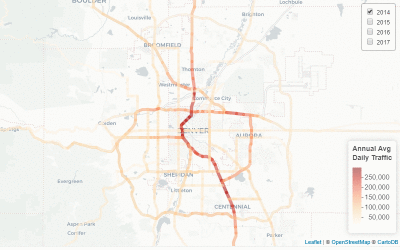Staying Safe on Denver Highways and Accident Riddled Roads
Table of Contents
Toggle
Denver ranks 19th in population size compared to other U.S. cities. The 2010 Census put Denver’s population at 600,158 and 10 years later the Census would have Denver surging to 704,621. During 2015, Colorado became the fastest growing state with many of those residents living on the front range, and that includes Denver highways and roads.
Along with the population increase is the growing number of cars on the roads. With people moving to Denver faster than the Colorado Department of Transportation (CDOT) can keep up with addressing congestion, there’s bound to be more accidents. Anyone who drives down 6th Avenue eastbound towards I-25 can tell you, there’s an accident virtually every morning.
Denver Highway Traffic Counts Increasing Drastically from 2014 to 2017
Heavy Denver highway traffic has continued to take place on the same routes year after year, it just gets worse in many of the same areas which are often found on I-25 and I-70. As new construction goes up, some areas enter the ranks for higher congestion, such as the Northfield/Stapleton area on the I-70 corridor. One thing is certain, as the population increases, so do the chances of being in an accident.
Intersection and Denver Highways Accidents
For the past few years, the Denver Police Department has compiled lists of the most dangerous intersections. Currently, South Santa Fe Drive and West Alameda rank number one with 37 accidents last year, followed closely by South Quebec and Leetsdale Drive coming in second with 34 accidents. North Kalamath Street and West Sixth Avenue tied with South Monaco Street and East Alameda Avenue for third and fourth places with 33 each.
While the number of accidents on the streets of Denver is high, they don’t compare to the number of accidents on the highways and major roadways. Where US Highway 36 coming down from Broomfield intersects with I-270 is one of the worst traffic hot spots in the city. Highway 285 is seeing an increase in accidents also caused in part by the increased traffic.
What’s Being Done About the Problem?
Two separate plans are in place to help curb the amount of traffic on Denver highways. The first is a plan by Denver’s Mayor Michael Hancock to get Denver residents to utilize public transportation, ride their bikes, or walk to work. His goal is to see 30% of residents doing this by the year 2030.
The second plan has gone into action and is called the 2018 Downtown Signal Retiming Project. Headed by Denver Public Works Traffic Engineering Manager, Michael Finochio, this project includes a year-long study concerning the traffic patterns in Denver. Implementation of the project should start during the late summer or early fall of 2019. One piece of the puzzle is upgrading current equipment so that signals throughout Denver will continue to work even through a power outage. Once the outage happens, it will send a signal to the operations facility so someone can be sent out to repair the faulty signal. A larger piece of the project is to figure out how to time signals for the best traffic flow. Sometimes a few seconds can make a huge difference. This is necessary because certain areas of the city are developing fast and causing a shift in traffic patterns.
6 Ways to Decrease Your Chances of an Accident on Denver Highways
Accidents can happen for a number of reasons, but there are precautions you can take to reduce your chance of being in one. Here is a list of things to address to keep yourself and others on the road safe:
- Tires – Tires play a big role in how fast your car can stop. The more tread on them the quicker the response time of the vehicle. Be sure your car’s tires are equipped with enough tread to stop in ample time and check tire pressure often.
- Peak Times – There are definite peak times of traffic in Denver. If possible, change the time of day you’re on the road to avoid as much traffic as possible. If it’s an option, go in to work earlier or after peak rush hour. When going shopping, take less-traveled roads or go during off-hours.
- Put Down the Cell Phone – It is illegal to talk on a cell phone while driving in Colorado, but you still see people doing it every day. Don’t be one of those people. Studies have shown that people looking at their cell phones have a slower reaction time than those who are driving drunk. The same goes for eating, applying makeup, shaving, or any other behavior that takes your eyes off the road.
- Use Your Signals – Everyone knows they’re supposed to use their signal but everyone doesn’t. No one can magically figure out what other cars are going to do which is why signaling is so important.
- Buckle Up – Accidents can become much more deadly when people don’t wear their seat belts. A simple click really can save your life.
- Be Courteous – Speeding up when you know a car is trying to get over is not conducive to safety on the roads. Be courteous and let the other driver over, especially when they are trying to merge on the highway. Also, don’t drive in the left lane, use it only for passing. When cars have to pass on the right it causes more accidents.
Finding a Car Accident Attorney in Denver, Colorado
A car accident can be a devastating experience. It is imperative to contact an honest, experienced Denver car accident attorney to advocate on your behalf. Jennifer Donaldson of Donaldson Law, LLC proudly represents clients in all types of car accidents, including rear-end accidents, high-speed impact crashes, DUI / drunk driving accidents, reckless driving accidents, and hit and run accidents.
Donaldson Law, LLC helps car accident victims throughout Denver County, including surrounding areas in Boulder County, Jefferson County, Adams County, and Arapahoe County. Call for an appointment to have Denver’s personal injury lawyer, Jennifer Donaldson, review your case by calling 303-458-5000 to take advantage of a free consultation. Find out what your case is worth today.

















